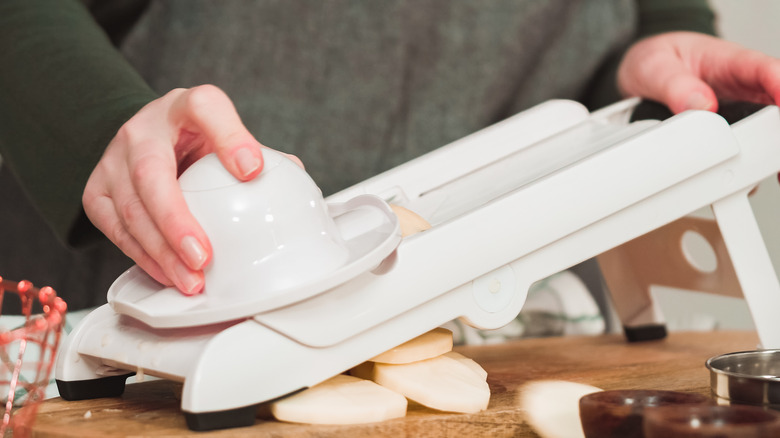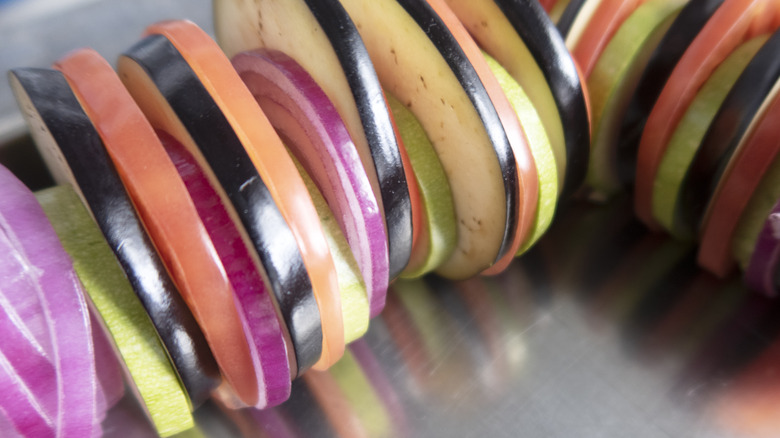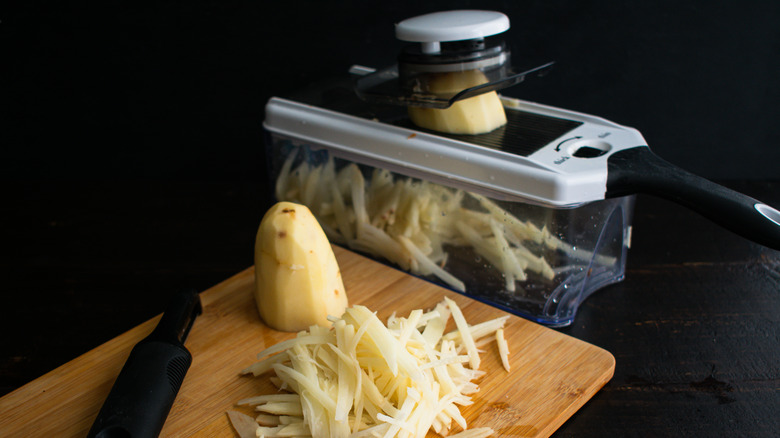Why You Should Consider A Mini Mandoline Over A Full-Sized One
We may receive a commission on purchases made from links.
There's no better way to ensure the potatoes in a classic creamy scalloped potatoes recipe will cook evenly than by slicing them evenly. A mandoline is perfect for this task. Plus, even an expert in knife skills couldn't do it as quickly.
A mandoline is a specialized slicing tool. Food is slid down a platform into the blade. The platform is adjusted to determine the thickness. In some mandolines, the blades can be replaced with ones that allow for waffled edges, or julienne cuts. Sliding food up and down a mandoline and watching the ideal slices pile up is incredibly gratifying. But pay attention, that blade is sharp and you're probably moving quickly. Add in some slippery food and stitches are a probable outcome.
The beauty of this tool is that it's a tool any cook uses. From fine dining affairs like Remy's classic French ratatouille down to a novice cook, these are knife ability equalizers. But there's no need to go for the largest one available.
When it comes to a mandoline, bigger isn't always better
As Food Network notes, mandolines come in all shapes, materials, and flexibility. The blades can be v-shaped, or a single blade set at an angle. The body can be heavy duty and made of stainless steel, or a simple hard plastic. They can have legs that allow it to stand up on its own, or just be hand-held above a bowl or cutting board. Do you want, or need, the attachments that will help you make Chick-fil-A waffle fries? All of these will impact prices. In their tests, the lineup of mandolines cost anywhere from just under $19 to nearly $100. Of course, you can spend even more, like this $450 version from the Webstaurant Store.
If you're the type of cook who appreciates precision enough to consider a mandoline, make sure you're comfortable with the mandoline's ability to be set to your liking. Some have a few preset thickness settings. Those could very well be fine. But, there are versions that can be set anywhere between the maximum down to as thin as you'd like.
Maybe the most important aspect to consider is size. If you're going to use a mandoline for slicing cucumbers, potatoes, and the like, there's no need for a mandoline's blade to be wider than a typical potato. If you plan on using a mandoline for sauerkraut prep, the larger version is for you.
Even a mini mandoline deserves respect
New York Times food reporter and cookbook author Melissa Clark confessed a love for their mini mandoline on the "Rachael Ray Show." In fact, it ranks among her "three favorite tools in the kitchen." Aside from being "cute," it's as large as they need, fits neatly into the dishwasher, and "makes her life so much easier." It'll solve some of the vegetables that you've been cutting the wrong way.
Pay special attention to the garlic slicing they perform, getting that close to the blade is typically a really bad idea. What they call a "mandoline glove" allows for that potentially dangerous slicing. Those are better known as cut resistant gloves, according to America's Test Kitchen. These won't make you invincible, but they should eliminate most average kitchen nicks and cuts. There's a huge variety of cut resistant gloves in the market. Their tests found them to all be effective. The most important aspects are a thin, well-fitted glove to maintain your dexterity. Being machine washable is ideal for sanitation.
Clark's favorite appears to be the Kyocera Advanced Ceramic Double-edged Mandoline. It's only $19 at Amazon. Note that it comes with a safety guard. If you don't want to use a cut resistant glove, be sure to use this crucial accessory.


